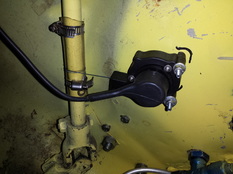Steering Sensor Mounting
Lots of people ask how to install different sensors. One of the most common, is the steering sensor. Their are special kits that are sold for steering sensors with belts and pulleys connecting a rotary sensor to the steering shaft, but these have the problem of needing to be tensioned and they often slip in fast steering inputs. A simple method to include a steering sensor is to use a string pot and wrap it around the steering shaft.
Once you have figured how to mount the sensor, which might require a small bracket, you simply wrap the sensor cable around the steering shaft and attach it. You have to make sure you have the steering wheel turned all the way to one side so that the string is retracted when turned in one direction and then the string is pulled out when turned the other direction.
The most common size string pot used is a 10" travel, which is fairly long for this application. You want to make sure that you use as much of the travel as possible to get the best resolution in your data. To do this, you can go back to a little bit of you high school geometry class and remember that the circumference of a circle (your steering shaft) is π multiplied by the shaft diameter multiplied by the number of turns from lock to lock. This will give you the travel you need to measure. As long as that is less than around 8" (the 10" travel minus the distance from the sensor to the shaft) you will be all set. If you find the sensor travel will be only a small portion of the sensor travel, you can increase the diameter of the shaft by putting a piece of rubber hose around it as you see in the picture.
Recent Posts
-
Position Sensors
So you want to know where something is? There are a lot of options! In motorsports we measure the po …Feb 2nd 2025 -
Pressure Sensor Info
So you want to measure a pressure? Gauge or absolute? Air or liquid? If air, gauge, absolute, or dif …Jan 22nd 2025 -
Driver health, monitoring, and performance
I was surfing Instagram and saw Dr. David Ferguson, of the Spartan Motorsports Performance Lab, post …Mar 22nd 2022


